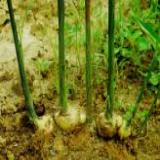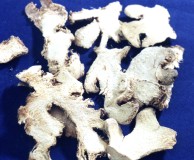Dried Ginger
http://www.100md.com
《e Natural Health Center》
 |
 |
 |
Herbs for Warming the Interior
Dried Ginger
Latin:
Rhizoma Zingiberis
Origin:
The dried rhizome of Zingiber officinale Rosc., a perennial plant, of the family Zingiberaceae. Probably native to southeastern Asia, its aromatic, pungent rhizome (underground stem) is used as a spice, flavouring, food, and medicine. Its generic name Zingiber is derived from the Greek zingiberis, which comes from the Sanskrit name of the spice, singabera.
, http://www.100md.com
Its use in India and China has been known from ancient times, and by the 1st century AD traders had taken ginger into the Mediterranean region. By the 11th century it was well known in England. The Spaniards brought it to the West Indies and Mexico soon after the conquest, and by 1547 ginger was being exported from Santiago to Spain.
The spice has a slightly biting taste and is used, usually dried and ground, to flavour breads, sauces, curry dishes, confections, pickles, and ginger ale. The fresh rhizome, green ginger, is used in cooking. The peeled rhizomes may be preserved by boiling in syrup. In Japan and elsewhere, slices of ginger are eaten between dishes or courses to clear the palate. Ginger is used medically to treat flatulence and colic.
, http://www.100md.com
The leafy stems of ginger grow about a metre high. The leaves are 15 to 30 centimetres long, elongate, alternate in two vertical rows, and arise from sheaths enwrapping the stem. The flowers are in dense, conelike spikes about 2 cm thick and 4 to 6 cm long, composed of overlapping green bracts, which may be edged with yellow. Each bract encloses a single, small, yellow-green and purple flower.
Ginger is propagated by planting rootstalk cuttings and has been under this type of cultivation for so long that it no longer goes to seed. The dried ginger rhizomes are irregular in shape, branched or palmate. Their colour varies from dark yellow through light brown to pale buff. Ginger may be unscraped (with all of its cork layer); partly scraped; or scraped or peeled (with all of its cork, epidermis, and hypodermis removed).
, http://www.100md.com
In China, ginger is cultivated and mainly produced in the provinces Sichuan, Guangdong, Guangxi, Hubei, Guizhou, Fujian, etc. Harvested in winter by lifting the rhizomes from the soil, then is cleaned, sliced and dried in the sun or baked at low heat until dry for use when raw.
Properties:
Pungent in flavor, hot in nature, it is related to the spleen, stomach, heart and lung channels.
, http://www.100md.com
Functions:
Warms the spleen and stomach and dispels cold, recovers depleted yang and removes obstruction in the channels and collaterals as well as warms the lungs and removes fluid retention from the interior.
Applications:
1. To treat cold pain in the abdomen, cold-type vomiting and cold diarrhea:
a) Vomiting due to stomach-cold and cold pain in the abdomen:
, 百拇医药
This herb is always used in combination with lesser galangal (Rhizoma Alpiniae Officinarum), e.g., Er Jiang Wan.
b) Cold pain in the abdomen, vomiting and diarrhea due to deficiency of the spleen and stomach with stagnation of cold:
This herb is mostly used with dangshen (Radix Codonopsis Pilosulae), largehead atractylodes rhizome (Rhizoma Atractylodis Macrocephalae), etc., e.g., Lizhong Wan.
, 百拇医药 2. To treat yang depletion syndromes, such as cold of the limbs due to yang depletion and barely palpable pulse due to yang deficiency of the heart and kidneys and excessive yin-cold in the interior:
This herb is always used in mutual enforcement with monkshood root (Radix Aconiti Praeparata), e.g., Sini Tang.
3. To treat asthma and coughing due to fluid retention of cold type, cold body and back and copious watery phlegm:
, 百拇医药
This herb is often used together with wild ginger (Herba Asari), Chinese magnoliavine fruit (Fructus Schisandrae), ephedra, etc., e.g., Xiao Qinglong Tang.
Dosage and Administration:
3-10 g.
Decoct this herb for oral administration.
Cautions on Use:
Reference Materials:
, http://www.100md.com
'Shen Nong's Herbal Classic' :
"To treat tightness in the chest, coughing or dyspnea caused by abnormal rising of lung-qi, diarrhea and dysentery by warming the spleen and stomach, arresting bleeding, inducing diaphoresis and relieving arthralgia due to wind-dampness. The raw herb is especially good."
'The Compendium of Materia Medica' :
"The dried ginger ... has four functions: Firstly, it activates heart-yang; secondly, it removes deep and stubborn cold from the zang-organs and fu-organs; thirdly, it emits cold-qi from the channels; fourthly, it treats abdominal pain due to affection by cold."
, 百拇医药
'Realistic Approach to Herbs' :
"Being very hot and non-toxic, the potency of the dried ginger will remains at a fixed position without any movement and this herb will give immediate effects for recovering depleted yang if used together with monkshood root (Radix Aconiti Praeparata) in the treatment of deficiency-cold in the stomach and the threatened exhaustion of primordial yang. Therefore, in the medical books there is a sentence saying that monkshood root will not be hot without any ginger."
, http://www.100md.com
Toxic or Side Effects:
Modern Researches:
Ginger contains about 2 percent essential oil; the principal component is zingiberene and the pungent principle of the spice is zingerone; and zingiberol, phellandrene, camphene, citral, linalool, gingerol, etc.
The oil is distilled from rhizomes for use in the food and perfume industries.
The alcohol extract of ginger can directly stimulate the heart and the motor centre of the blood vessels. Dried ginger can arrest vomiting, tranquilize the patient, kill pain, dispel wind, strengthen the stomach and arrest coughing., 百拇医药